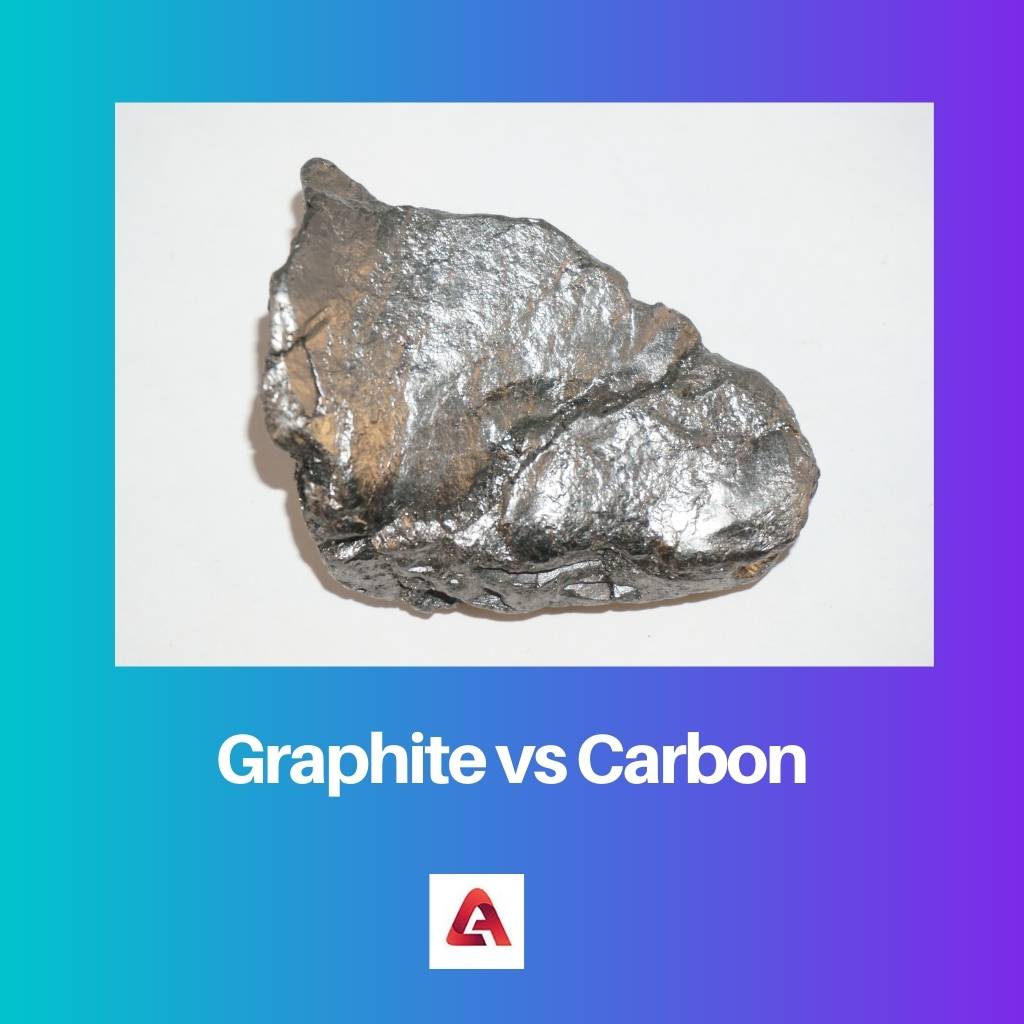La ciencia está en todas partes. Lo podemos ver en los alimentos que comemos, el aire que respiramos, el agua que bebemos, etc. Es el estudio de todo lo que nos rodea.
Puntos clave
- El grafito es un material blando, negro y resbaladizo, mientras que el carbono es un elemento químico de apariencia opaca y propiedades físicas variadas.
- El grafito tiene una mayor resistencia al calor, la corrosión y la electricidad, mientras que el carbono tiene un punto de fusión más bajo y reacciona con el oxígeno a altas temperaturas.
- El grafito fabrica electrodos, lápices, lubricantes y crisoles, mientras que el carbono se usa en la producción de acero, celdas de combustible y producción de fibra de carbono.
Grafito vs Carbono
El grafito es un alótropo del carbono, lo que significa que es carbono. Químicamente es carbono, pero sus propiedades físicas lo diferencian del carbono.

El grafito es un alótropo del carbono, lo que significa que es químicamente lo mismo que el carbono, está compuesto en su totalidad por átomos de carbono, pero su estructura física es diferente. Su forma física única lo hace diferente de los elementos de carbono convencionales.
El carbono es uno de los elementos más críticos entre 118 elementos conocidos. Es un elemento con el número atómico seis.
Tabla de comparación
| Parámetros de comparación | Grafito | Carbono |
|---|---|---|
| Sentido | El grafito es un alótropo del carbono. | El carbono es uno de los elementos entre los 118 elementos conocidos. |
| Etimología | El grafito está hecho de la palabra griega graphein, que significa 'escribir'. | El carbono está hecho de la palabra latina carbo, que significa carbón vegetal. |
| Estructura | El grafito tiene una estructura de red de capas hexagonales. | El carbono no tiene ninguna estructura fija o particular. |
| Aparición | El grafito ocurre solo en una forma, una estructura particular de átomos de carbono. | El carbono se presenta en varias formas, lo que da como resultado millones de compuestos de carbono. |
| Uso | El grafito tiene usos limitados, como refrigerante y lubricante. | El carbono tiene muchos usos en diversas formas, como petróleo crudo, nutrientes, etc. |
¿Qué es el grafito?
El grafito es un alótropo del carbono. El carbono tiene muchas formas y estructuras. El grafito es el cristalino estructura de los átomos de carbono.
En el grafito, un átomo de carbono está unido a otros tres átomos de carbono mediante un enlace covalente. Forma una capa hexagonal de átomos de carbono y capa por capa; crea una estructura cristalina.
Ocurre en diferentes formas naturalmente. Por ejemplo, el grafito amorfo, el grafito en grumos, el grafito pirolítico altamente ordenado y el grafito cristalino son algunos ejemplos de diferentes formas de grafito.
Es anisótropo y se siente grasoso cuando se toca. También conduce la electricidad.

¿Qué es el carbono?
El carbono es el sexto elemento de la tabla periódica moderna. Pertenece al segundo período y al decimocuarto grupo de la tabla periódica.
El carbono recibe su nombre de su palabra latina, 'carbo', que significa carbón.
Forma millones de compuestos por su propiedad tetravalente y de catenación. Estas grandes cantidades de compuestos se estudian en diferentes grupos.
Después del hidrógeno, el helio y el oxígeno, es el elemento más abundante en todo el universo. La propiedad del carbono depende de sus diferentes alótropos; por ejemplo, el grafito, un alótropo del carbono, es el material más blando, mientras que otro alótropo del carbono, conocido como diamante, es el material más complejo jamás conocido.
Todos cosas vivas están hechos de carbono; por lo tanto, es esencial para toda la vida posible en cualquier lugar. Aparte de los seres vivos, es necesario de muchas maneras.

Principales diferencias entre grafito y carbono
- El grafito y el carbono son químicamente iguales, pero su estructura física los hace diferentes. El grafito tiene un diseño hexagonal, pero el carbono se puede encontrar en estructuras de forma.
- El grafito se encuentra solo en varias formas de grafito. Por otro lado, el carbono tiene diferentes formas como un diamante, grafito, etc.
- El grafito está hecho de la palabra griega graphein, que significa 'escribir', mientras que el carbono está hecho de la palabra latina 'Carbo', que significa carbón vegetal.
- El grafito es muy suave y conduce la electricidad, pero las propiedades del carbono dependen de los diferentes alótropos que forma.
- Por otro lado, el Grafito se utiliza como lubricante en lápices, electrodos, etc.; El carbono tiene muchos usos debido a sus muchos alótropos.

- https://www.sciencedirect.com/science/article/pii/S0378775301006711
- https://www.annualreviews.org/doi/pdf/10.1146/annurev.ms.03.080173.001211
Última actualización: 11 de junio de 2023

Piyush Yadav ha pasado los últimos 25 años trabajando como físico en la comunidad local. Es un físico apasionado por hacer que la ciencia sea más accesible para nuestros lectores. Tiene una licenciatura en Ciencias Naturales y un Diploma de Postgrado en Ciencias Ambientales. Puedes leer más sobre él en su página de biografía.

Me sorprende lo complejo que puede ser el mundo de la ciencia. Esta publicación realmente destaca las complejidades del grafito y el carbono.
Este artículo ofrece un análisis exhaustivo del grafito y el carbono, proporcionando una mejor comprensión de sus propiedades y diferencias.
No podría estar mas de acuerdo. La riqueza de conocimientos contenida en esta publicación es realmente impresionante.
El artículo es un recurso valioso para quienes buscan información detallada sobre el tema. Está bien escrito e informativo.
¡Absolutamente! La claridad y profundidad de la información son notables en esta publicación.
El artículo es un tesoro de ideas sobre las diferencias entre el grafito y el carbono, presentado de una manera interesante y bien informada.
No podría estar mas de acuerdo. Es un trabajo encomiable.
Absolutamente. Esta publicación establece un alto estándar para el contenido informativo en química.
Agradezco la claridad del artículo y las comparaciones están muy bien trazadas. Facilita la comprensión y diferenciación entre grafito y carbono.
Sí, este artículo es un gran recurso educativo para cualquier persona interesada en la ciencia.
Este artículo es una gran fuente de información sobre las diferencias entre carbono y grafito. Proporciona información muy detallada sobre los dos elementos y sus propiedades.
Estoy encantado de haber aprendido mucho más sobre el grafito y el carbono leyendo este artículo.
Estoy totalmente de acuerdo. Es raro encontrar contenido tan detallado e informativo sobre estos temas.
El contenido no sólo es informativo sino también atractivo. La publicación hace justicia al tema complejo de una manera clara y accesible.
Absolutamente. Es una combinación perfecta de información académica y un estilo de escritura fácil de leer.
De hecho, la publicación logra el equilibrio adecuado entre ser educativa y atractiva.
Las comparaciones presentadas en este artículo son esclarecedoras. Es una pieza de alta calidad que mejora la comprensión de estos elementos químicos.
En efecto. El estilo de presentación me pareció muy atractivo e intelectualmente estimulante.
El artículo es un testimonio del fascinante mundo de la ciencia. La profundidad de los detalles y la información transmitida por expertos la convierten en una lectura impresionante.
De hecho, la publicación cautiva el interés del lector de principio a fin.
Si bien el tema es bastante complejo, el artículo aclara efectivamente las distinciones entre grafito y carbono. Una lectura esclarecedora para los entusiastas de la ciencia.
Estoy de acuerdo. La profundidad del conocimiento y la forma de explicación son verdaderamente encomiables.
Absolutamente. Es encomiable lo bien que esta publicación simplifica conceptos tan complejos.